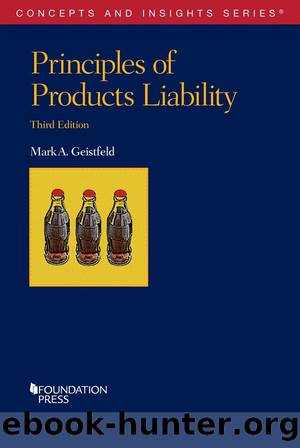Principles of Products Liability by Mark A. Geistfeld

Author:Mark A. Geistfeld
Language: eng
Format: epub
ISBN: 9781642425826
Publisher: West Academic
Published: 2020-10-15T00:00:00+00:00
III.The Puzzle of Comment k
In exempting an âunavoidably unsafeâ product from strict liability, comment k states that âsuch a product, properly prepared, and accompanied by proper directions and warning, is not defective, nor is it unreasonably dangerous.â Apparently such a product could be defective only in design, explaining why the majority rule limits comment k to this class of cases.
The majority rule, though, is puzzling. By treating comment k as an affirmative defense, the majority rule places the burden of proof on the defendant manufacturer to show that the design of the drug or medical device passes the risk-utility test. For all other products, however, the plaintiff in the vast majority of jurisdictions bears the burden of proving that the product design fails the risk-utility test.25 Instead of providing an affirmative defense, comment k would seem to subject the manufacturers of pharmaceuticals to an evidentiary burden more onerous than the one they bear for other types of products, a rather baffling attribute for an affirmative defense that is supposed to benefit manufacturers.
This problem stems from the failure to interpret comment k within its historical context. Recall that when the American Law Institute promulgated the Restatement (Second) section 402A rule of strict products liability in the mid-1960s, it based the rule on cases involving defects defined by a self-defeating product malfunction, such as contaminated food or an exploding bottle of soda.26 Because section 402A was formulated by reference to product malfunctions, the comment k exemption from this rule of strict liability presumably applies to this type of defect. The majority rule does not limit the exemption to this class of cases, nor have commentators flagged this problem.27
Under section 402A, the manufacturer is strictly liable for a product malfunction that frustrates consumer expectations, even if it âhas exercised all possible care in the preparation and sale of the 190
product.â28 Strict products liability forecloses any defense based on risk-utility evidence in the case of a malfunction. By allowing the manufacturer to employ risk-utility evidence to avoid liability for a malfunction, comment k provides a true affirmative defense that exempts the manufacturer from strict products liability. When applied to product malfunctions, comment k makes evident sense.
But this interpretation creates another puzzle. Comment k states that an âunavoidably unsafeâ product is not âunreasonably dangerousâ if âproperly prepared, and accompanied by proper directions and warning.â Relying on this language, most courts and commentators assume that comment k does not apply to manufacturing defects.29 Based on this case law, the Restatement (Third) applies strict liability to prescription drugs or medical devices containing a manufacturing defect.30 However, a manufacturing defect can cause a product to malfunction, as in the case of an exploding soda bottle. How could comment k coherently eliminate strict liability for malfunctions while still recognizing that strict liability applies to products that are not âproperly preparedâ?
Download
This site does not store any files on its server. We only index and link to content provided by other sites. Please contact the content providers to delete copyright contents if any and email us, we'll remove relevant links or contents immediately.
Killers of the Flower Moon by David Grann(3240)
Machine Learning at Scale with H2O by Gregory Keys | David Whiting(2292)
Will by Will Smith(2042)
Guns, Germs and Steel by Diamond Jared(1884)
Borders by unknow(1785)
The Room Where It Happened by John Bolton;(1721)
The Color of Law by Richard Rothstein(1575)
Once Upon a Broken Heart by Stephanie Garber(1485)
Water Rights and the Environment in the United States by John Burch(1414)
Friends, Lovers, and the Big Terrible Thing by Matthew Perry(1328)
Examples & Explanations: Administrative Law by William F. Funk & Richard H. Seamon(1326)
A Short History of War by Jeremy Black(1300)
HBR's 10 Must Reads 2022 by Harvard Business Review(1256)
Pharmacy Practice and The Law by Richard Abood(1254)
The Strength In Our Scars by Bianca Sparacino(1248)
That Every Man Be Armed by Stephen P. Halbrook(1237)
The Guarded Gate by Daniel Okrent(1220)
515945210 by Unknown(1208)
Injustices by Ian Millhiser(1199)
